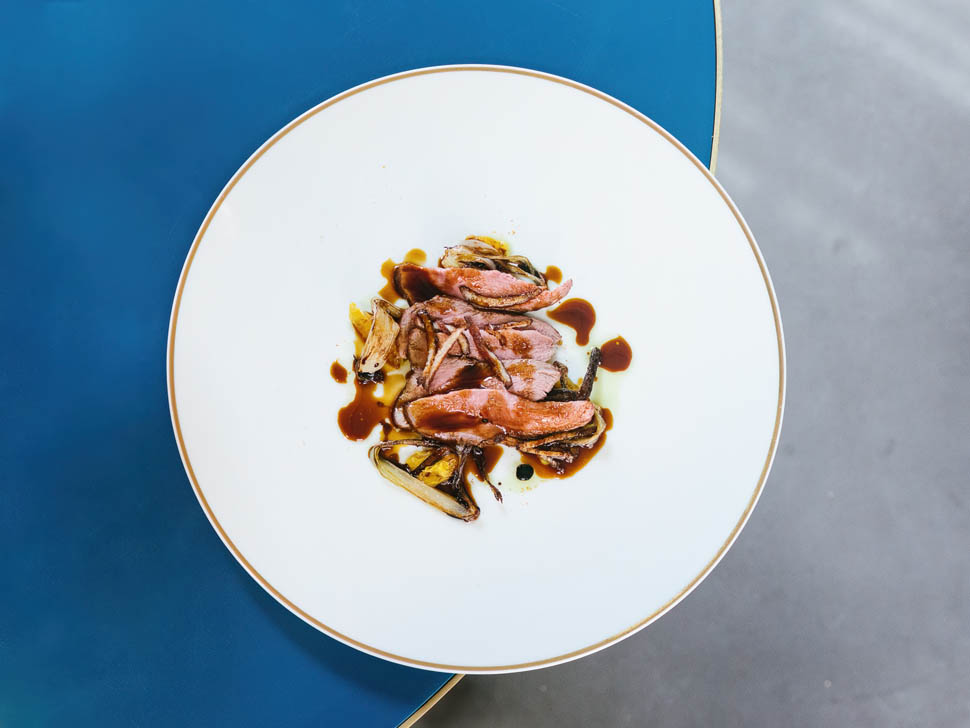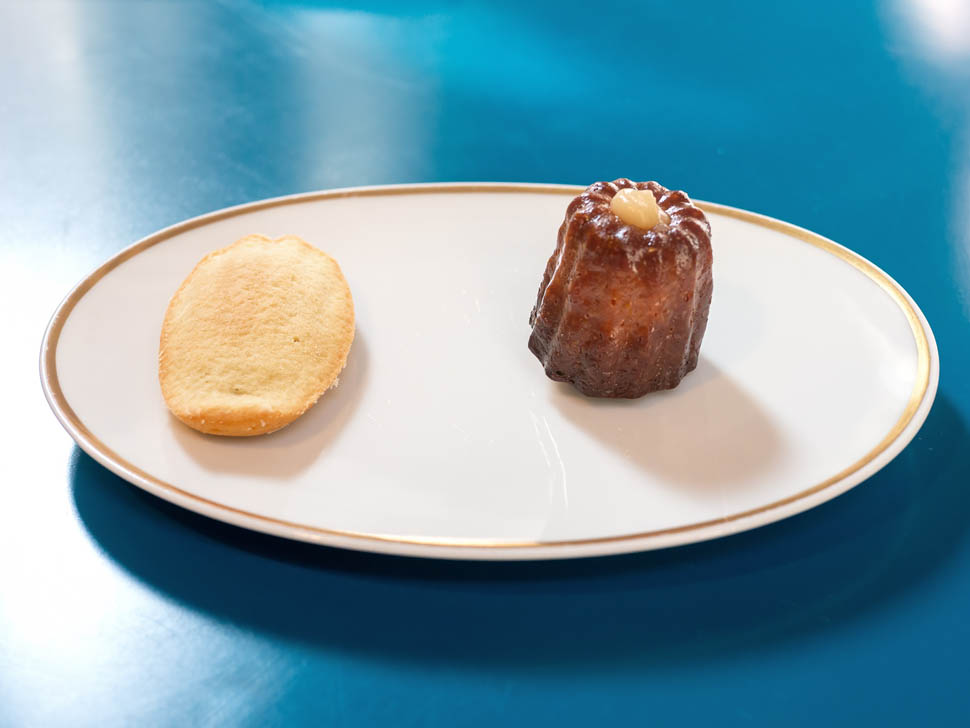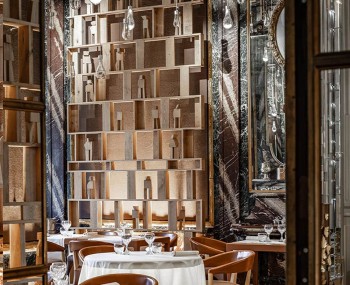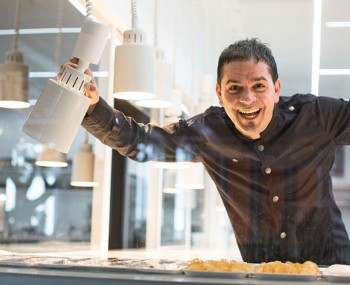A compelling and highly identifiable idea, which on paper might seem fatiguing to the palate, but turns out to be anything but: Luigi Taglienti recodes the sauces with a register that lightens and lends an unexpected note.
The story
The severed heads of the saints in the Renaissance church of Sant'Agostino make a fair impression, but scanning them with the eye gives off a bewitching magnetism. The largest church in Piacenza, deconsecrated since the late 1700s when Napoleon occupied it and his troops fired decapitated all the low statues, is majestic. Leaving intact only those placed high up, probably too far out of range. Today this imposing space has become Volumnia, a place of hypnotic fascination that Enrica De Micheli, a gallery owner of antiques and historic design for thirty years, has returned to the city thanks to a massive recovery effort.

"I am just back from a meeting with some state property officials," she tells us, " who complimented me by saying that they always take me as a virtuous example, because it is rare that a private person has taken it upon themselves to restore a structure of this caliber, and they proposed that I include it in a museum network." Volumnia, under its five aisles displays historical design from throughout the 20th century, particularly the 1940s and 1950s; a monographic exhibition is always set up during the Salone del Mobile; the last edition was dedicated to Michele De Lucchi. An architect of articulate eclecticism, he masterfully ranges between industrial creations, architecture and sculptural works, blending whimsy, technological innovation and technical precision. Just a forty-minute drive from the southern area of Milan, Enrica's church/gallery is a treasure trove of furniture complements and decorative objects of unusual beauty and rare value, such as Bogo, Carlo Bartoli's suede sofa with small support tables between the arms; or Simone Crestani's Sparkling Cabinet , almost surrealist-inspired, pink lacquered and sprinkled with blown glass bubbles.

“This place has had so many lives,” De Lucchi tells us, “ after the suppression of religious orders, the monks left the monastery adjacent to the church and the entire structure passed to the state. Then later it was military storage for the barracks next door.” From the side exit of the building, crossing the charming dehors, we reach what is now the "IO Luigi Taglienti" restaurant created in the rooms of the monastery's former carpentry shop, which has come to the present day in a state of great dilapidation, now finely restored, where the original inscription denoting its function is still inscribed on the lower part of the outer wall: "Carpentry and Maintenance."

“Before I bought the complex, from the very first visit, I always thought that I would like to make a restaurant out of the woodworking area,” the gallery owner confesses, “ then, through a mutual friend, I met Luigi, and I told him my idea. He came to see the place and fell in love with it." Volumnia opened in 2018, after twelve months of construction; the following year, restoration of the carpentry and courtyard began, but lockdown blocked the opening when it was almost all finished. So the official opening was postponed until June 2022.
The chef and the restaurant

Thirty covers, distributed in a space in which the peacock blue of the tables and seats diffuses an Art Nouveau allure, although the style is contemporary and elegantly minimal. With the enormous Moon lamp by Davide Groppi totally imposing itself on the eye, but only when the scene is not the prerogative of the chef. Who often comes out into the room to present dishes, even to serve wine, with a register of almost aristocratic grace, free of any pedantry or display of self, as often happens even to those with far fewer titles to do so. Surely the only Italian chef who would be able to cook while wearing a Caraceni under his chef's jacket, after all, the claim of Italy's most famous men's tailoring company reads “With one of our suits you can even fence, ” let alone turn a risotto.

Forty-five years old, from Savona, Taglienti began as a boy to devote himself to hospitality, helping his mother in the family beach establishment. After hotel school, a most valuable imprinting came alongside Ezio Santin at Antica Osteria del Ponte in Cassinetta di Lugagnano, a three-starred restaurant just outside Milan. An inescapable stint in France at the Palme D'Or in Cannes, where he refined his innate sense of rigor, realizing that discipline can be paved with elegance, with prodigious results. In 2007, at 28, he returned to Italy and joined Giorgio Chiesa at Antiche Contrade in Cuneo, where, a year later, he earned his first Michelin star. It is 2012 when he arrives in Milan and for two years leads the kitchen of Trussardi alla Scala, before seeing materialized the project that up to that moment most reflects his personality, Lume, an apologia of candor expressed in all its facets, apart from the red of the Michelin macaron hung at the entrance after twelve months. Restaurant that closes its course with the arrival of the pandemic emergency in 2020.

"I love jazz, the original one" Taglienti began, " in jazz, the standard is a composition that has become ingrained in the common repertoire of musicians. And I think the sauces represent the standards of all cooks. The sauce is the DNA of the dish, and we start from there to build it. We put an ear to the noises of the kitchen and out came the Standards menu, where the sauces are the concept from which the dish develops."
A tasting hinged on great classics, and Taglienti masters classicism so fluently that in no time he turns it upside down into avant-garde, projecting the classic into the best possible futuristic dimension.
The dishes

At the aperitif we sip Pinè di Paganini, a classic organic method of malvasia, moscato, trebbiano, sauvignon and ortrugo named after a family ancestor who left his job in high fashion in Geneva to return to farming in the Piacenza area. “We deceive the wait with a welcome appetizer ,” says the chef as he arrives at the table , “I love pas-touché,” and with the boys we work with the goal of leaving the product as natural as possible, without intervening too much, preferring above all vegetable materials. So, without the imposition of tasting sequences, comes raspberry; harissa butter, a spicy Tunisian sauce with fresh red chili, garlic, olive oil; tarragon. White rapanello with beaten Ligurian langoustine vegetable; a financier with almond, chervil, Parmigiano, lemon; rhubarb, maple juice, fresh cilantro; recovery salad with herbs, flowers, citrus and anchovy colatura. In a small cocotte, Ligurian marmande tomatoes emulsified with red fruits and sorrel.


Accompanying the bread basket is “Taggiasco di Montagna” monocultivar oil from the Sant'Agata oil mill in Oneglia, from olives harvested in Imperia at an altitude of 600 m. Great delicacy, but with character. As Japanese tradition dictates, it starts with a refreshing broth, which resets and prepares the palate for everything else, from the citrusy and tart freshness, with celery, yuzu, oil and coriander. The modern potage, according to Taglienti, starts with a conventional base and then includes oyster, letting it rest on the warm plate to release its second best water, pork snout with sparkling wine, banana and spinach. Roundness, savoriness and astringency that shoulder each other sorting a diffuse harmony.


The contemporary soup concept is developed by distributing coquillage marinière and foie gras on the plate drizzled with an extraordinary lemon chicken sauce and eel water. The progression of the course is also expressed through the mutation of structures in the dishes. The start was given to a liquid, textures and concentrations of flavors were added as we went along, until we reached the press. So steamed quail, coconut milk champignon chantilly, and crab juice. Even the Thermidor homard, traditionally with egg yolk, cognac and baked gruyere, finds its contemporary version, with lobster boosted by a firm jus de boeuf, and a wafer of Gruyère AOC.



The duck starts with a bigarade sauce, veering between a Peking and an orange duck, with braised spring onion, the skin double-cooked, spring onion oil, and the canonical sauce passed through the bird press. “Here's a duck sauce ”, Luigi explains, ”split with the bones, and pulled to the right point, bound with blood at the last moment, slowly cooked to make it a little more melting. Spring onions with passion fruit and cherries. Finally, persillade parsley with echalotte, shallots, and citrus zeste."

“Ultimately Standards is a menu of sauces only ,” summarizes the chef, “ I originally had in mind to do four menus a year in addition to the carte: vegetable, fish, game, defining themes four times a year. Instead, having already more than ten sauces on the line, we thought to proceed with a different work. And so the idea was born." A compelling and highly identifiable idea, which on paper might seem fatiguing to the palate, thinking of academic versions of sauces, but here they are recoded with a register that lightens and lends an unexpected note.

It closes with an ode to essentiality, a childhood memory, grandmother's cream, which for Taglienti is also the squaring of lemon, one of his favorite ingredients.

Contact
IO Luigi Taglienti
Via Pietro Giordani, 14, 29121 Piacenza PC
Phone. 0523 604703











